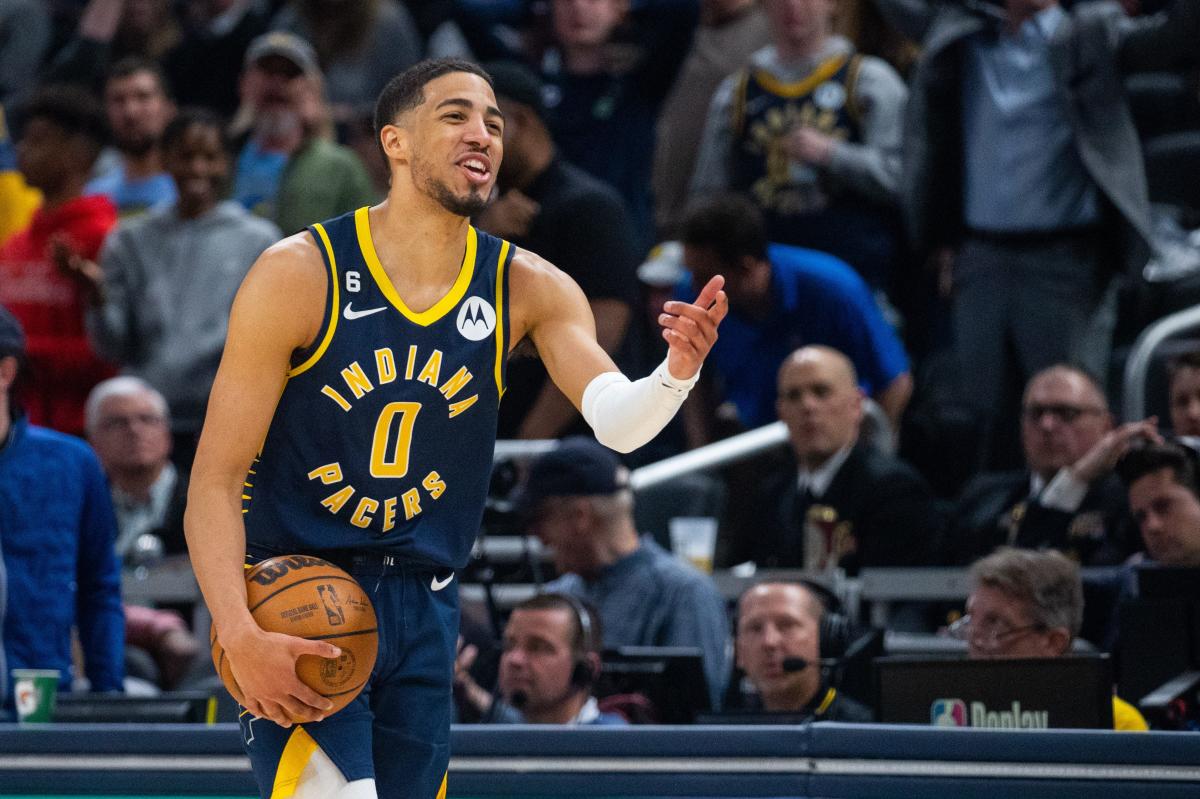Pacers coach Rick Carlisle was asked in Las Vegas how the acquisition of forward Obi Toppin from the Knicks might shake up the Pacers’ depth chart and force players to change positions. With close to three months to go before training camp, he wasn’t having that discussion yet.
“It’s July 8,” Carlisle said at halftime of the Pacers’ first NBA Summer League game. “I’m not gonna write anything in ink with lineups and rotations or any of that stuff. There’s still a long way to go in the summer.”
There is, and there’s no reason for Carlisle to come to any conclusions before training camp begins in the fall. But that doesn’t mean we can’t speculate.
There’s still a chance there could be movement with the Pacers’ roster this offseason. They have been linked to trade talks surrounding Raptors All-Star forward Pascal Siakam, and landing him would obviously create a massive shift in the Pacers’ roster dynamics and the trajectory of their rebuild. But with the draft and the early stages of free agency in the books, the Pacers have 15 men on guaranteed contracts and three more in a place to take two-ways. From a personnel standpoint, they might indeed be ready to roll in 2023-24.
Competition for several positions promises to be stiff and in an era of increasingly “positionless” basketball, there will certainly be some lineup fluidity even once the season starts. Still, as an academic exercise, now is a good time to take a look at the roster at a position-by-position level to get some sense of the shape these Pacers could take.
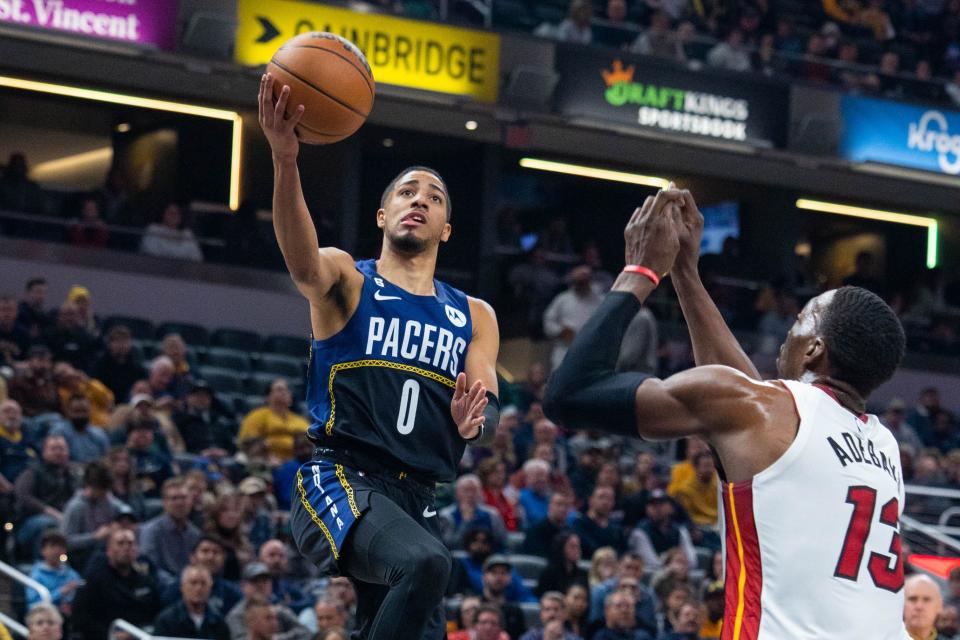
Point Guard
-
Tyrese Haliburton
-
Andrew Nembhard
-
T.J. McConnell
-
Bruce Brown
There’s obviously no competition for the starting job at point guard even though the Pacers have a lot of depth. The All-Star Haliburton is their man, the face of the franchise, their cornerstone, their partner in the building of the roster. After he averaged 20.7 points and 10.4 assists per game last season, the Pacers signed him to a max contract extension, completing that as soon as the NBA calendar allowed it. He has one more year on his rookie scale contract, and next season he’ll be on a five-year deal worth up to $260 million.
But after Haliburton, the Pacers will have some decisions to make at point guard.
Nembhard was a revelation as a rookie last season. The No. 31 overall pick narrowly missed being named second-team All-Rookie. He averaged 9.5 points and 4.5 assists per game and was one of the Pacers’ top two perimeter defenders, taking on the assignment of guarding one of the best players in the world every night. He started 63 of the 75 games he played in, starting at shooting guard next to Haliburton when the All-Star was healthy, giving the Pacers a secondary ball-handler in the starting lineup. When Haliburton was out, Nembhard was the starting point guard, and he had some spectacular performances in that role.
Nembhard will certainly continue to be Haliburton’s understudy, but the question of how best to get Nembhard on the floor when Haliburton is healthy becomes a trickier one this season. The Pacers signed Brown to a two-year, $45 million deal and they’ll presumably want him to start at either shooting guard or small forward, and getting him in the lineup will provide the defense they relied on Nembhard for last year. They’ll also likely want to start either Bennedict Mathurin or Buddy Hield on the wing for scoring purposes.
The Pacers could make Nembhard their second-unit point guard, but that could minimize the use of McConnell, who is coming off one of his best seasons as a pro.
The 31-year-old veteran saw his minutes cut to 20.3 per game, but averaged a career-high 8.7 points per game, shooting a career-best 44.1% from 3-point range, though on limited volume. He proved he can still break opponents down off the dribble and get to the lane at will for layups or short jumpers, and he made 55.6% of his 2-point shots, the second-best figure of his career. He can still distribute, averaging 5.3 assists against 1.9 turnovers per game last season, and he’s still a pesky defender averaging 1.1 steals per game. His veteran presence has more value, as the Pacers have not re-signed George Hill or James Johnson Jr. from last season’s roster and don’t currently have roster space to do so. McConnell would be the oldest player on the team if they are not retained. He still has a lot left in the tank and value on both ends of the floor, so the Pacers could still trust him to run the second unit or they could move him to a team who can use his skill set.
Brown will have other positional opportunities at shooting guard and small forward, but if the Pacers find themselves depleted by injury on a short- or long-term basis, Brown can handle point guard opportunities if needed. There were several games during last season when Haliburton and McConnell were out, so it’s likely Brown will have to man the point in at least a few of the season’s 82 games.
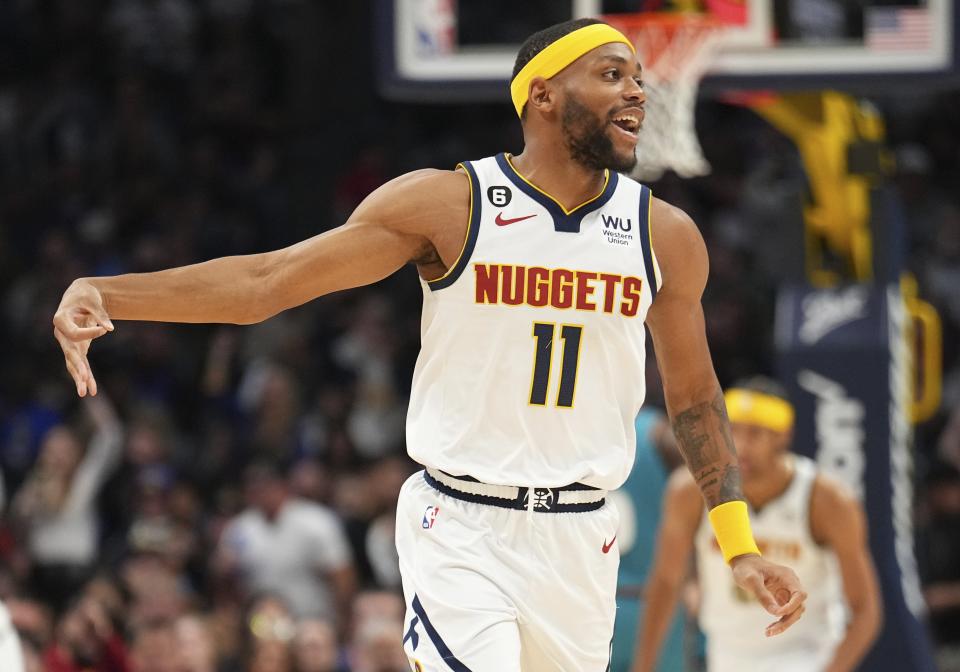
Wing, Defense Oriented
-
Bruce Brown
-
Aaron Nesmith
-
Andrew Nembhard
-
Ben Sheppard
The Pacers have a lot of options at the shooting guard and small forward positions — spots that have bled together to the point of being nearly identical as the game has become more perimeter oriented. We felt the best way to organize and rank those options would be to operate using the following premises: 1. The Pacers’ best scoring wings and best defensive wings are not the same people. 2. Given that, Carlisle will eventually decide to balance his lineups so he always has one wing on the floor who can score and one he can trust to defend an opponent’s top player. There will be times when they can mix things up there and create some lineups for scoring punch and others to go heavy on defense, but we’re presuming the starting lineup will stick to that principle.
Carlisle said after Brown’s signing that he expects the former Nuggets utility man to be in the starting lineup. During Denver’s title run, he showed he can play any position 1-4 and certainly guard anyone in those spots. The 6-4, 202-pounder averaged 1.1 steals per game in the regular season and playoffs, so he can create offense with defense. Carlisle trusts him to guard all the top wings, and though he doesn’t have the ceiling as a scorer that Bennedict Mathurin or Buddy Hield do, he can provide value on the offensive end. Last season, Brown averaged a career-high 11.5 points per game to go with 4.1 rebounds and 3.4 assists. He’s an excellent transition scorer and he has some outside touch, hitting on 35.8% of his 3-point attempts last season.
The 6-5 Nesmith started at power forward last season because the Pacers didn’t have better options. He still might play some power forward, but with the additions of Obi Toppin and Jarace Walker, he’ll be able to spend more time at his natural positions, 2 and 3. The Pacers used him and Nembhard to guard opponents’ top perimeter scorers, so he has the experience of taking on superstars. He has to cut down his fouling in those circumstances, but he seemed to find some sense of how to handle those situations as the year wore on. He averaged 10.1 points per game with athleticism around the rim and range from beyond the arc. He was streaky as a 3-point shooter and went through lengthy droughts, but ended up shooting 36.6% on 3s.
Nembhard won’t find as easy of a path to a starting job at the 2 this year, but the Pacers could pair him with McConnell in the second unit to put two ball-handlers and on-ball defenders together. He could take the starting spot if Brown misses time or he and Brown could play together against smaller lineups.
Sheppard might find it hard to find immediate playing time, but the former All-Missouri Valley Conference defender showed signs in Summer League that he can be a good perimeter defender, and he proved throughout his time at Belmont that he could shoot, averaging 18.8 points per game and shooting 41.5% on 3s.
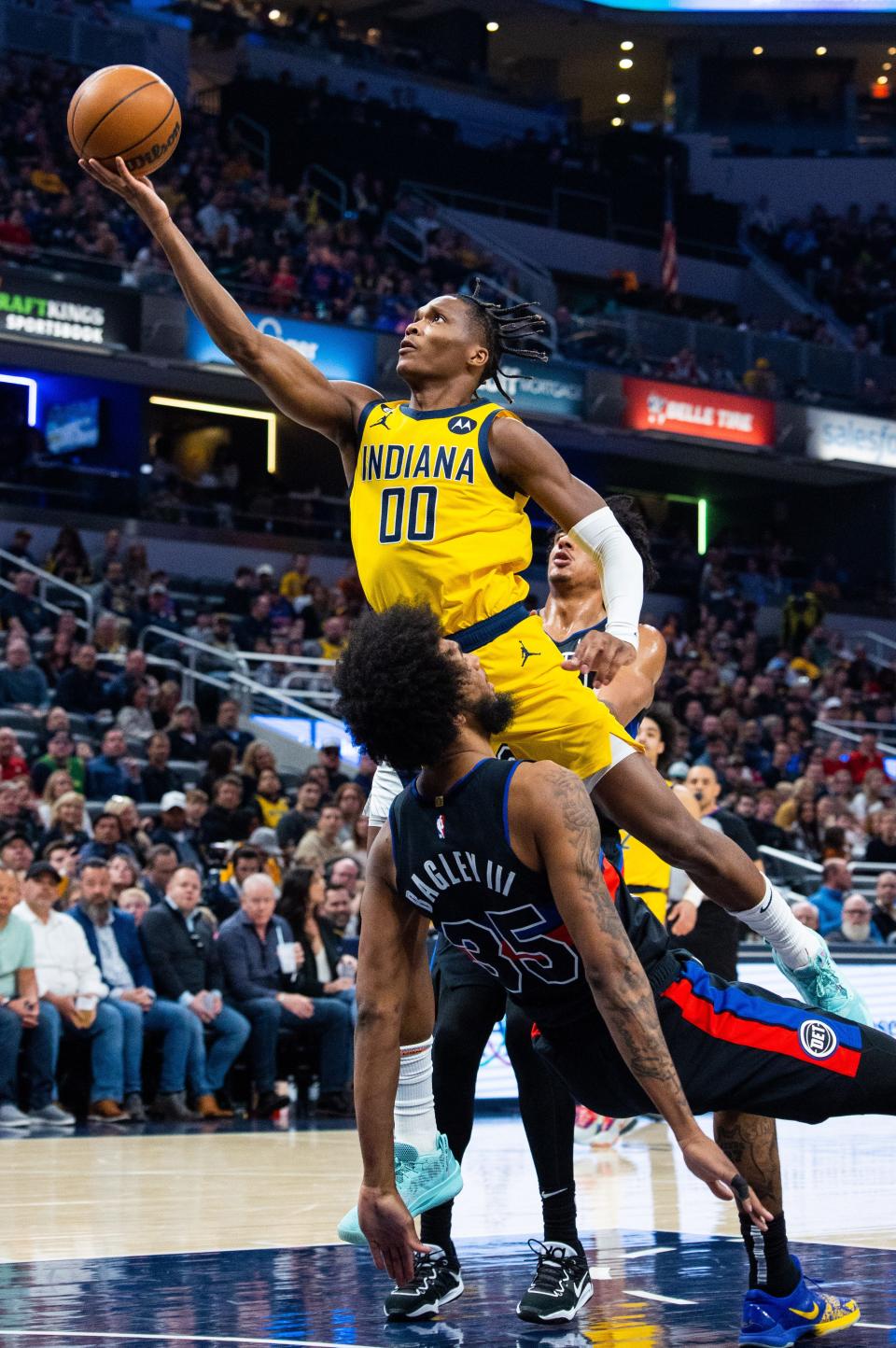
Wing — Offense oriented
-
Bennedict Mathurin
-
Buddy Hield
-
Jordan Nwora
Mathurin wants to be the best two-way player in the NBA and become a force on defense the same way Michael Jordan and Kobe Bryant were. He’s not there yet, of course, but the Pacers plan to keep forcing him into tougher situations until he is, because at 6-5, 210 pounds he has the frame to be good on that end.
On offense, he’s already excellent. He averaged 16.7 points per game last season, finishing second to Orlando’s Paolo Banchero among rookies and scored the third most points of any rookie in Pacers history. His jumper still needs some work — he hit a modest 32.3% of his 3-pointers and was just OK in the mid-range — but he made 62.6% of his shots within 3 feet so he’s an excellent rim finisher. He also averaged more free throw attempts than anyone else on the team last year. Mathurin is arguably the Pacers’ second most important asset after Haliburton, so the Pacers seem devoted to moving him into a starting role this year.
Hield actually scored a little more than Mathurin last season, averaging 16.8 points per game, and he got there without going to the rim nearly as much. The 30-year-old Hield is still one of the best shooters in the game. He finished second in the NBA in 3-pointers last season with 288 with Klay Thompson the only player who made more. That figure shattered Reggie Miller’s franchise record for made 3s in a year. Hield made 42.5% of his attempts, and the only player who made more than 200 3s and also shot a higher percentage was Stephen Curry.
Hield’s offensive game doesn’t have the same versatility as Mathurin’s. He’s not a great defender either and at 30, he doesn’t have the same capacity for improvement on that end as Mathurin. Still Hield’s shooting and the gravity it creates will get him on the floor.
The 6-9, 225 pound Nwora is primarily a power forward, but his offensive game is very perimeter oriented so he could play small forward in a bigger lineup. He was buried behind Giannis Antetokounmpo and Khris Middleton with the Bucks, so his playing time was minimal before the Pacers acquired him in February, but he averaged 13.0 points per game in 24 games with Indiana. Late in the season when the Pacers focused on development more than winning games, Carlisle put Nwora in ball screen actions as a ball-handler and he showed he could create for himself and for others off the dribble. He probably won’t beat out Hield and Mathurin for a starting job, but he could get some work at the 3.
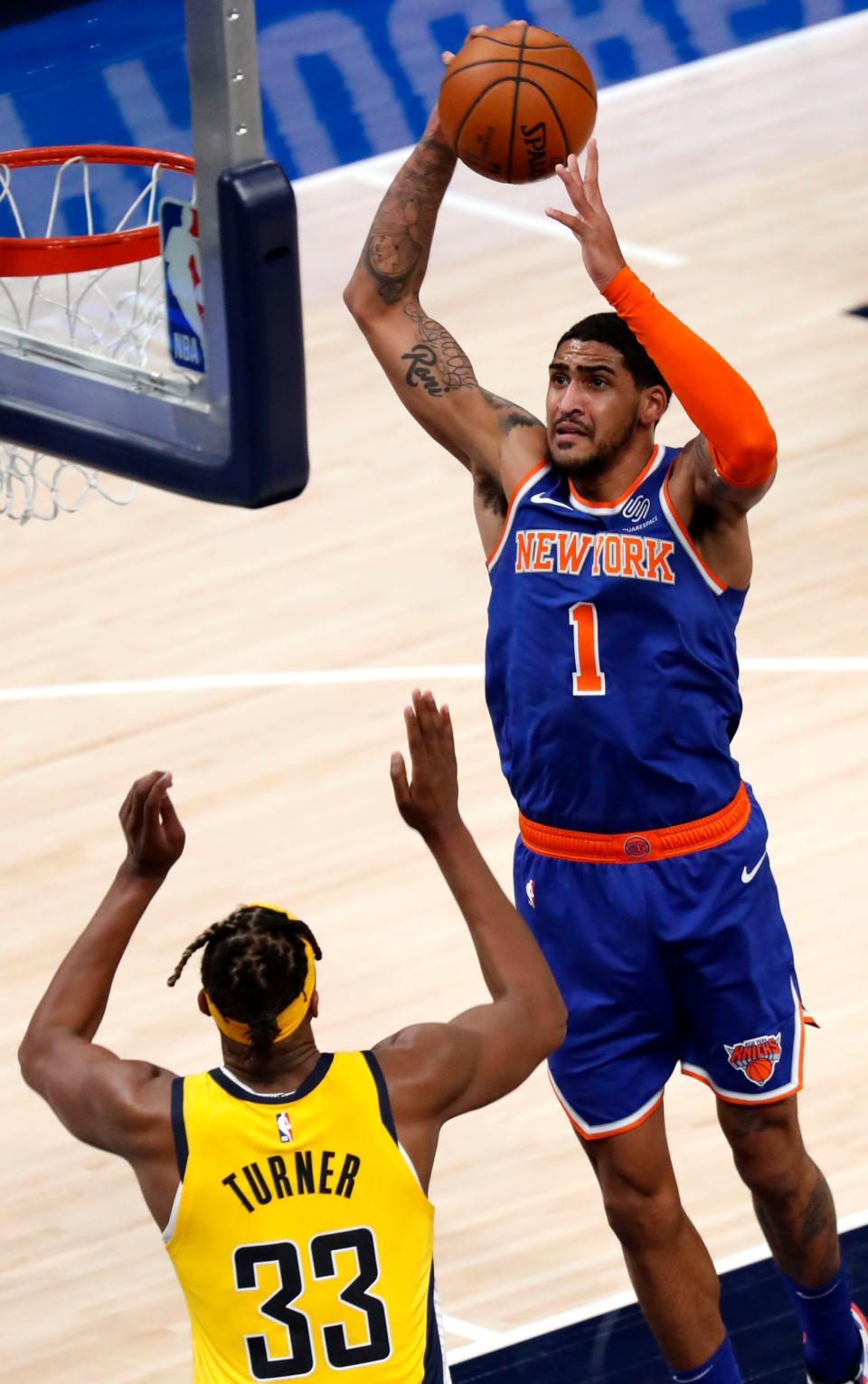
Power Forward
-
Obi Toppin
-
Jarace Walker
-
Jordan Nwora
-
Aaron Nesmith
Power forward was the biggest weak point on the Pacers’ roster last season, so they fortified the spot with the Toppin trade and the drafting of Walker.
Toppin is the presumptive starter because he has experience, even though he spent the last three seasons buried behind Julius Randle on the Knicks’ depth chart. He never averaged more than 17.1 minutes in a season for the Knicks, but he was productive, especially on offense in short stretches. The former No. 8 overall pick and consensus national player of the year at Dayton in 2019-20 averaged 17.0 points and 7.2 rebounds per 36 minutes in his time with the Knicks. He has legit power forward size at 6-9, 220 pounds, he hit 32.5% of his 3-pointers in New York and he has outstanding leaping ability for his size, which makes him an exceptional finisher in transition.
Walker, the No. 8 pick out of Houston, might need some time to develop into an NBA starter, but his performance in the NBA Summer League backed up everything the Pacers’ brass said about him in the draft. His shooting left something to be desired as he made just 34.3% of his field goal attempts and 17.9% of his 3s in four games, but he averaged 14.3 points, 7.8 rebounds and 3.3 assists per game. He proved he could defend smaller players on the perimeter and swat shots around the rim on defense. On offense, he sometimes ran the point even though he was the nominal power forward, and dished out excellent passes in half court and transition situations. He has some growing to do, but spending a year behind Toppin while he learns might set him up to be a starter in the future with Toppin’s contract set to expire after this year.
Nwora promises to be in the power forward mix as well. He could find himself stuck in a similar situation to what he went through in Milwaukee, but neither Toppin nor Walker are so entrenched above him as Antetokounmpo was with the Bucks as to deny him an opportunity to catch eyes. Nwora hit on 42.2% of his 3-pointers in his time with the Pacers last season, so that alone will keep him in the discussion.
Toppin, Walker and Nwora have all joined the Pacers since February and that has made it less necessary for the undersized Nesmith to play the 4. That said, the Pacers were so impressed by his perseverance and his ability to play above his size that they will clearly want to get him on the floor somehow. They might not do it at the expense of bigger options at the 4, but they might get him some work there if he can’t find any at the 2 or the 3.
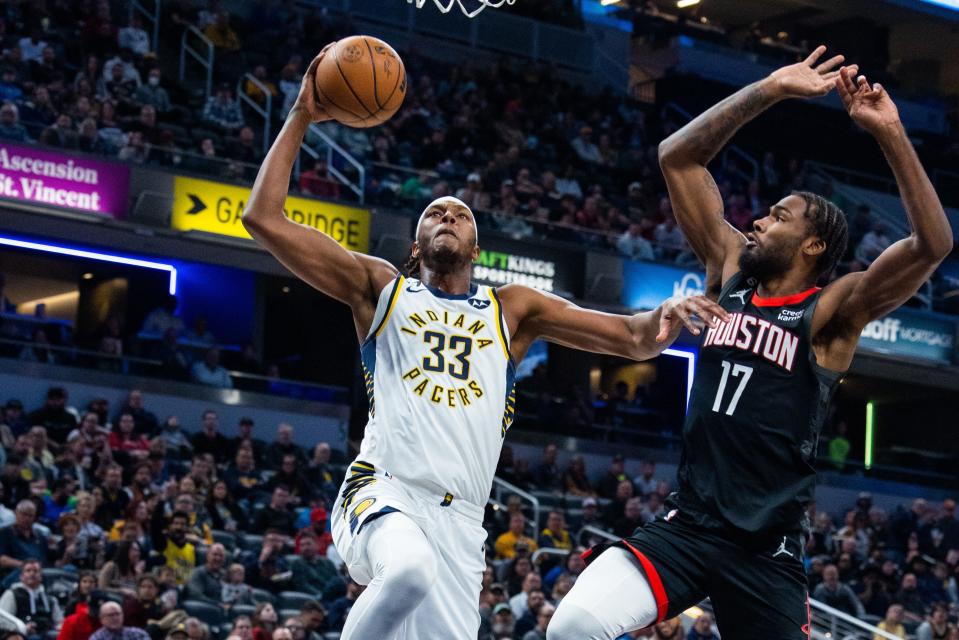
Center
-
Myles Turner
-
Isaiah Jackson
-
Jalen Smith
-
Daniel Theis
After Haliburton, Turner is the safest bet to be an opening day starter. He was rewarded for career highs in scoring (18.0 points per game) rebounding (7.5 per game) and effective field goal percentage (.612) with a two-year renegotiated contract that will pay him approximately $40 million over the next two years. He’s still one of the best shot blockers in the NBA (2.3 per game last season) and the combination of his move to center and his pairing with Haliburton are unlocking parts of his offensive game that didn’t come to light until last year.
The battle for the minutes behind Turner is still as even as it was at the end of last season. The Pacers never really did choose between the 21-year-old Isaiah Jackson and the 23-year-old Jalen Smith and for good reason. Jackson has more leaping ability and energy, which makes him a very good rebounder, shot blocker and lob finisher, as he averaged 15.7 points, 9.7 rebounds and 3.2 blocks per 36 minutes last season. However, Smith is actually the better rebounder and has a better outside shot and all-around offensive game. Smith averaged 18.1 points and 11.1 rebounds per 36 minutes, though a more modest 1.7 blocks per 36.
Smith has a little more length and a more refined game. Jackson has a little more bounce. It’s certainly not a bad thing to have two young, talented big men behind a 27-year-old starter, but they are very much taking development time away from each other. Jackson had an excellent NBA Summer League performance, grabbing 25 rebounds in two games, so it’s possible he could pull ahead.
The Pacers also still have Daniel Theis on the roster, though it’s not clear at all where he could fit in the mix. The 31-year-old played in seven games in February after returning from knee surgery, but was then shut down so Jackson and Smith would get more development time. In that time, the 6-8, 245-pound Theis showed that he could still defend, box out, set bone-jarring screens, handle, pass and shoot as well as he could when he was helping the Celtics in their playoff runs as a bench big man. That would seem to be valuable for a contending team, but the Pacers either haven’t seen fit to move him or haven’t come up with a return. At this point, he still seems to be the player most likely to move before the season starts.
This article originally appeared on Indianapolis Star: Pacers will have tough competition on 2023-24 depth chart
